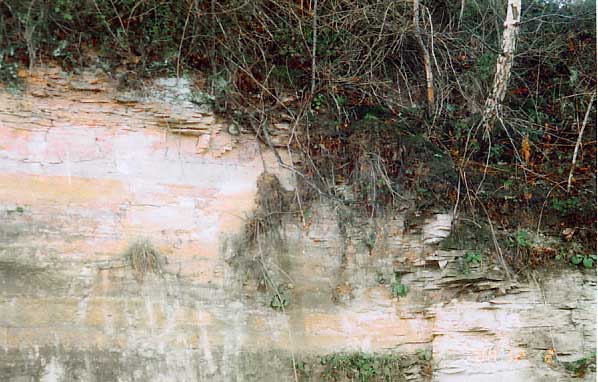| Stone
roofing in England update |
| Stone roofing
in England was published in English Heritage Research Transactions Volume
9: Stone Roofing in 2003. Since then more information and some errors have
come to light |
|
The entry for Surrey, Sussex, Kent should
include Charlwood stone (Small Paludina limestone) not Chatwall stone. |
-
New
information. P74 In the Ordovician geology of Shropshire.
At Cheney Longville an old quarry has
been re-discovered at SO410852 in Longville Wood/Plantation. This may be
La Touche's roofing source (1923 Field Meeting - Plowden, in Transactions
of the Caradoc and Severn Valley Field Club, 7: 2, 61-3.) It has steeply
dipping beds at 68 degrees with fissile rock visible. 'The quarry is in
the unit known originally as the Chatwall Flags close to the boundary with
the overlying Chatwall Sandstone. Nowadays they are both part of the Chatwall
Sandstone Formation (Ordovician)' Graham Lott. |
-
New
information. P81 Welsh Marches and Bristol - Permian
The source of roofing known informally
as Grinshill Flagstone (Thompson 1993, 1995) is undefined but is believed
to be equivalent to the Tarporley Siltstone Formation (Link
to description on BGS website). The TSF was also formerly known as
the Waterstones (BGS British Regional Geology, volume 10, Central England
3rd edition p68 et seq). The stratigraphy for the southern part of the
Cheshire Basin is (old terms in brackets):
Mercia Mudstone Group:
Bollin Mudstone Fm. (ie,
Keuper Marl)
Tarporley Siltstone Fm. (thought
to be the Grinshill Flagstone) (Waterstones) Sherwood Sandstone Group:
Helsby Sandstone Formation (this
is the Grinshill Sandstone) (Keuper Sdst)
Wilmslow Sandstone Fm. (Upper Mottled
Sdst)
Chester Pebble Beds Fm. Bunter Pebble
Beds)
Kinnerton Sandstone Fm. (Lower Mottled
Sdst)
( Ed Hough BGS personal comment)
The 1788 painting of the
old Grinshill
Church accessible through the Secret
Shropshire website appears to show a stone roof with a hint that the
stone slates might have been bedded in mortar. This church was replaced
1839 - 40 with one in red sandstone designed by J Carlin Jun.
The thinly fissile beds in the TSF can
be seen at the top of the active Grinshill Quarry.
There are no roofs known to survive
today but it is possible that D C Davies FGS saw some in the early C20.
Refering to the use of sandstone for roofing he commented that 'The thin
calcareous flags that lie between the Bunter and Keuper sandstones in Shropshire,
at Grinshill, were formerly used for the same purpose.' (Daviies D C, 1912,
A treatise on slate & slate quarrying, Crosby Lockwood, London,
p77 5th ed. |

|
|
The attribution of the Corndon Hill
stone slate as igneous is wrong. It is in fact a very fine, laminated siliceous
sandstone (Graham Lott BGS personal comment). In Vernacular Buildings of
Shropshire (Moran M, 2003 Logaston Press, Almeley, Herefordshire, p42 )
it is described thus: The hill itself is a large dolorite intrusion ...
however on the south western slope of the hill the altered Hope Shales
on the margin of the dolorite produce finely laminated material which was
extensively quarried for roofing and flooring. |
|
|
|
